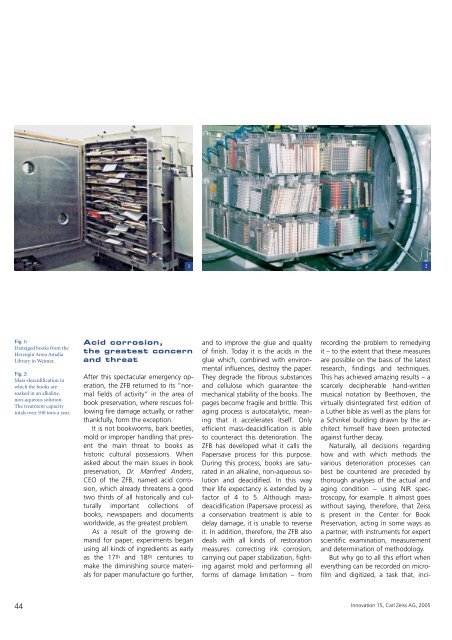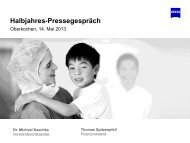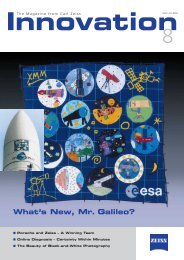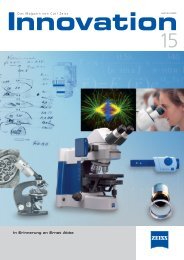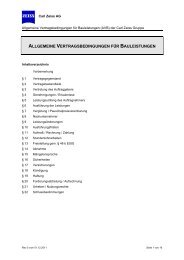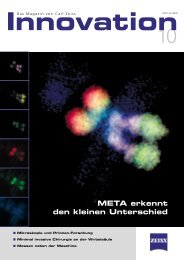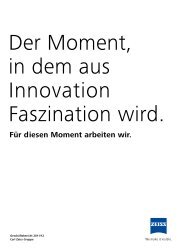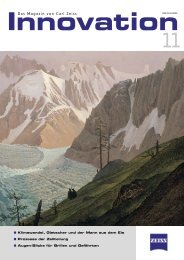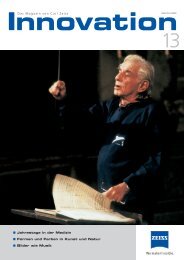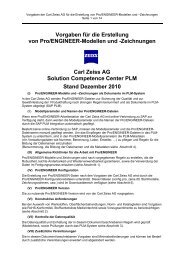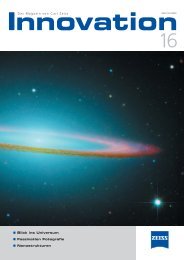Download PDF - Carl Zeiss
Download PDF - Carl Zeiss
Download PDF - Carl Zeiss
You also want an ePaper? Increase the reach of your titles
YUMPU automatically turns print PDFs into web optimized ePapers that Google loves.
Fig. 1:<br />
Damaged books from the<br />
Herzogin Anna Amalia<br />
Library in Weimar.<br />
Fig. 2:<br />
Mass-deacidification in<br />
which the books are<br />
soaked in an alkaline,<br />
non-aqueous solution.<br />
The treatment capacity<br />
totals over 100 tons a year.<br />
44<br />
Acid corrosion,<br />
the greatest concern<br />
and threat<br />
After this spectacular emergency operation,<br />
the ZFB returned to its “normal<br />
fields of activity” in the area of<br />
book preservation, where rescues following<br />
fire damage actually, or rather<br />
thankfully, form the exception.<br />
It is not bookworms, bark beetles,<br />
mold or improper handling that present<br />
the main threat to books as<br />
historic cultural possessions. When<br />
asked about the main issues in book<br />
preservation, Dr. Manfred Anders,<br />
CEO of the ZFB, named acid corrosion,<br />
which already threatens a good<br />
two thirds of all historically and culturally<br />
important collections of<br />
books, newspapers and documents<br />
worldwide, as the greatest problem.<br />
As a result of the growing demand<br />
for paper, experiments began<br />
using all kinds of ingredients as early<br />
as the 17th and 18th centuries to<br />
make the diminishing source materials<br />
for paper manufacture go further,<br />
1 2<br />
and to improve the glue and quality<br />
of finish. Today it is the acids in the<br />
glue which, combined with environmental<br />
influences, destroy the paper.<br />
They degrade the fibrous substances<br />
and cellulose which guarantee the<br />
mechanical stability of the books. The<br />
pages become fragile and brittle. This<br />
aging process is autocatalytic, meaning<br />
that it accelerates itself. Only<br />
efficient mass-deacidification is able<br />
to counteract this deterioration. The<br />
ZFB has developed what it calls the<br />
Papersave process for this purpose.<br />
During this process, books are saturated<br />
in an alkaline, non-aqueous solution<br />
and deacidified. In this way<br />
their life expectancy is extended by a<br />
factor of 4 to 5. Although massdeacidification<br />
(Papersave process) as<br />
a conservation treatment is able to<br />
delay damage, it is unable to reverse<br />
it. In addition, therefore, the ZFB also<br />
deals with all kinds of restoration<br />
measures: correcting ink corrosion,<br />
carrying out paper stabilization, fighting<br />
against mold and performing all<br />
forms of damage limitation – from<br />
recording the problem to remedying<br />
it – to the extent that these measures<br />
are possible on the basis of the latest<br />
research, findings and techniques.<br />
This has achieved amazing results – a<br />
scarcely decipherable hand-written<br />
musical notation by Beethoven, the<br />
virtually disintegrated first edition of<br />
a Luther bible as well as the plans for<br />
a Schinkel building drawn by the architect<br />
himself have been protected<br />
against further decay.<br />
Naturally, all decisions regarding<br />
how and with which methods the<br />
various deterioration processes can<br />
best be countered are preceded by<br />
thorough analyses of the actual and<br />
aging condition – using NIR spectroscopy,<br />
for example. It almost goes<br />
without saying, therefore, that <strong>Zeiss</strong><br />
is present in the Center for Book<br />
Preservation, acting in some ways as<br />
a partner, with instruments for expert<br />
scientific examination, measurement<br />
and determination of methodology.<br />
But why go to all this effort when<br />
everything can be recorded on microfilm<br />
and digitized, a task that, inci-<br />
Innovation 15, <strong>Carl</strong> <strong>Zeiss</strong> AG, 2005


